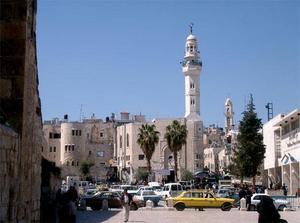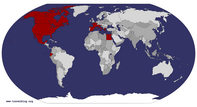Advertisement
Published: November 14th 2006

 Bethlehem
Bethlehem
Bethlehem, West Bank - IsraelNov 14, 1993
*
City official name :Bethlehem
*
Founded date : *
Location :West Bank Province
*
Elavation :? ft (? m)
*
Area :Approximately ? square miles (? km²).
*
Facts :Bethlehem (Arabic بيت لحم Bayt Laḥm (help·info) "house of meat"; Standard Hebrew בית לחם "house of bread", Bet léḥem / Bet láḥem; Tiberian Hebrew Bêṯ léḥem / Bêṯ lāḥem; Greek: Βηθλεέμ) is a city in the West Bank under Palestinian Authority considered a central hub of Palestinian cultural and tourism industries.
The city has great significance for Christianity as it is the birthplace of Jesus of Nazareth. The traditional site of Rachel's tomb, which is an important holy site in Judaism, lies at the city's outskirts. Bethlehem is also home to one of largest Palestinian Christian communities in the Middle East. It lies about 10 km (6 mi) south of Jerusalem, standing at an elevation of about 765 m (2,510 ft) above the sea, thus 30 m (100 ft) higher than Jerusalem. The Bethlehem agglomeration includes the small towns of Beit Jala and Beit Sahour, the latter also having biblical significance.
The Church of the Nativity, built by Constantine the Great (330 AD), stands in

 Bethlehem
Bethlehem
Bethlehem, West Bank - Israelthe centre of Bethlehem over a grotto or cave called the Holy Crypt, which according to Christian tradition is the place where Jesus was born. This is perhaps the oldest existing Christian church in the world. Close to it is another grotto, where Jerome the Latin father spent thirty years of his life in translating the Scriptures into Latin. (See Vulgate).
Bethlehem is home to Bethlehem University, a major Roman Catholic institution which was founded under the direction of the Vatican.
The city, located in the "hill country" of Judah, was originally called Ephrath (Gen. 35:16, 19; 48:7; Ruth 4:11). It was also called Beth-lehem Ephratah (Micah 5:2), Beth-lehem-judah (1 Sam. 17:12), and "the city of David" (Luke 2:4). It is first noticed in Scripture as the place where Rachel died and was buried "by the wayside," directly to the north of the city (Gen. 48:7). The valley to the east was the scene of the story of Ruth the Moabitess. There are the fields in which she gleaned, and the path by which she and Naomi returned to the town.
Bethlehem is the birth-place of David, the second king of Israel, and it is also the

 Bethlehem
Bethlehem
Bethlehem, West Bank - Israelplace where he was anointed as king by Samuel (1 Sam. 16:4-13); and it was from the well of Bethlehem that three of his heroes brought water for him at the risk of their lives when he was in the cave of Adullam (2 Sam. 23:13-17).
Since it was distinguished above every other city as the birth-place of "Him whose goings forth have been of old" (Micah 5:2), it was here that the birth of Christ was expected. Accordingly, the gospels (Luke 2:4 and Matthew 2:1) report that Jesus, whom they proclaim as the Messiah, was born in Bethlehem, although he grew up in Nazareth. Matthew reports that Herod had "all the children that were in Bethlehem, and in all the coasts thereof, from two years old and under" killed when Jesus was born (Matt. 2:16, 18; Jer. 31:15). Jesus' family escaped this fate for him, by fleeing to Egypt and then returning after Herod had died, shortly thereafter.
The city was wrecked during Bar Kokhba's revolt (132-135 AD) and the Romans set up a shrine to Adonis on the site of the Nativity. Only in 326 was the first Christian church constructed, when Helena, the mother of

 Bethlehem
Bethlehem
Bethlehem, West Bank - Israelthe first Christian emperor, Constantine, visited Bethlehem.
During the Samaritan revolt of 529, Bethlehem was sacked and its walls and the Church of the Nativity destroyed, but they were soon rebuilt on the orders of the Emperor Justinian. In 614, the Persians invaded Palestine and captured Bethlehem. A story recounted in later sources holds that they refrained from destroying the Church of the Nativity on seeing the magi depicted in Persian clothing in one of the mosaics.
In 637, shortly after Jerusalem was captured by the Muslim armies, the Caliph Umar ibn al-Khattab visited Bethlehem and promised that the Church of the Nativity would be preserved for Christian use.
In 1099, Bethlehem was captured by the Crusaders, who fortified it and built a new monastery and cloister on the north side of the Church of the Nativity. The town prospered under their rule. On Christmas Day 1100 Baldwin I, first king of the Frankish Kingdom of Jerusalem, was crowned in Bethlehem, and that year a Latin episcopate was also established in the town.
In the 1160s the nave of the Church of the Nativity was redecorated with mosaics showing the councils of the church. An ally

 Bethlehem
Bethlehem
Bethlehem, West Bank - Israelof King Amalric I of Jerusalem, emperor Manuel I Comnenus of Byzantium, was one of the patrons of the work. On the south wall, an inscription in Greek reads: "the present work was finished by Ephraim the monk, painter and mosaicist, in the reign of the great emperor Manuel Porphyrogenitos Comnenus and in the time of the great king of Jerusalem, Amalric." Interestingly, the emperor's name was placed first, in recognition of his role as overlord and protector of the Crusaders at the time.
However, in 1187, Saladin captured Bethlehem from the Crusaders, and the Latin clerics were forced to leave. Saladin agreed to the return of two Latin priests and two deacons in 1192. However, the town suffered from the loss of the pilgrim trade. Bethlehem was briefly returned to Crusader control by treaty between 1229 and 1244. In 1250, with the coming to power of Rukn al-Din Baibars, tolerance of Christianity declined, clergy left the town, and in 1263 the walls of the town were demolished. The Latin clergy returned to the town over the following century, establishing themselves in the monastery adjoining the Basilica, and in 1347 the Franciscans gained possession of the Grotto of the

 Bethlehem
Bethlehem
Bethlehem, West Bank - IsraelNativity as well as the right to administer and maintain the Basilica.
During the years of Ottoman control from 1517 on, custody of the Basilica was bitterly disputed between the Catholic and Greek Orthodox churches.
From 1831 to 1841 Palestine was under the rule of Muhammad Ali of Egypt. During this period the town suffered an earthquake as well as the destruction of the Muslim quarter by troops, apparently as a reprisal for a murder. In 1841, Bethlehem came under Ottoman rule once more, and so it remained until the end of the First World War and the imposition of the British Mandate of Palestine.
In the 1947 resolution by the United Nations General Assembly to partition Palestine, Bethlehem was included in the special international enclave of Jerusalem to be administered by the United Nations. Jordan occupied the city during the 1948 Arab-Israeli War. Many refugees from areas captured by Israeli forces in 1947 - 1948 came to Bethlehem, setting up encampments in the north of the city near the road to Jerusalem and on the hillside to the south between the city and Solomon's Pools. These later became the official refugee camps of Beit Jibrin (or

 Bethlehem
Bethlehem
Bethlehem, West Bank - Israelal-'Azza) and 'A'ida (in the north) and Deheisheh in the south. This influx of refugees changed the demography of Bethlehem considerably.
Jordan retained control of the city until 1967, when Bethlehem was captured by Israel along with the rest of the West Bank.
On December 21, 1995, Bethlehem became one of the areas under the full control of the Palestinian Authority. It is capital of the Bethlehem district. The current population of the town is about 40,000. The Christian population is no longer the majority, but a special statute requires that the mayor and a majority of the municipal council must nevertheless be Christian.
With the escalation of the Israeli-Palestinian conflict, Bethlehem has been the site of many confrontations. In May 2002, during an Israel Defense Forces raid into the city, a number of locals (some of whom were armed) fled into the Church of the Nativity. It became the site of a 5-week stand-off. The number of people inside was estimated between 120 and 240. It was alleged by Palestinians that several Palestinians inside the church compound were shot dead by Israeli snipers during the siege. The siege ended with an agreement for 13 militants to

 Bethlehem
Bethlehem
Bethlehem, West Bank - Israelbe sent via Cyprus to various European counties and another 26 to be sent to Gaza. The rest were set free. The IDF stated that 40 explosive devices were found and removed from the compound after the standoff was concluded.
Bethlehem, Beit Sahour and Beit Jala are currently surrounded by Israeli checkpoints and roadblocks, with the main road to Jerusalem cut off at the border of Jerusalem's municipal area - at Rachel's Tomb. Bethlehem residents are only allowed into Jerusalem (the main social, economic and religious centre of the region) with special permits that are usually refused. Travel to other parts of the Palestinian controlled territories of the West Bank is also impeded and sometimes prevented. The city has periodically been placed under strict curfew, preventing residents from leaving their homes. Palestinians are not allowed to enter the Jewish holy site of Rachel's Tomb, which is on the outskirts of the city. Since Bethlehem and the nearby biblical Solomon's Pools lie in Area A, Israeli citizens cannot go there without a permit from the Israeli military authorities.
The construction by Israel of the West Bank barrier has had a severely negative impact on Bethlehem; politically, socially, and

 Bethlehem
Bethlehem
Bethlehem, West Bank - Israeleconomically. The barrier runs along the northern side of the town's built-up area, within metres of houses in 'A'ida refugee camp and the Jerusalem municipality.
Advertisement
Tot: 0.098s; Tpl: 0.012s; cc: 14; qc: 27; dbt: 0.0307s; 1; m:domysql w:travelblog (10.17.0.13); sld: 1;
; mem: 1.1mb













anonymous
non-member comment
God bless!!!